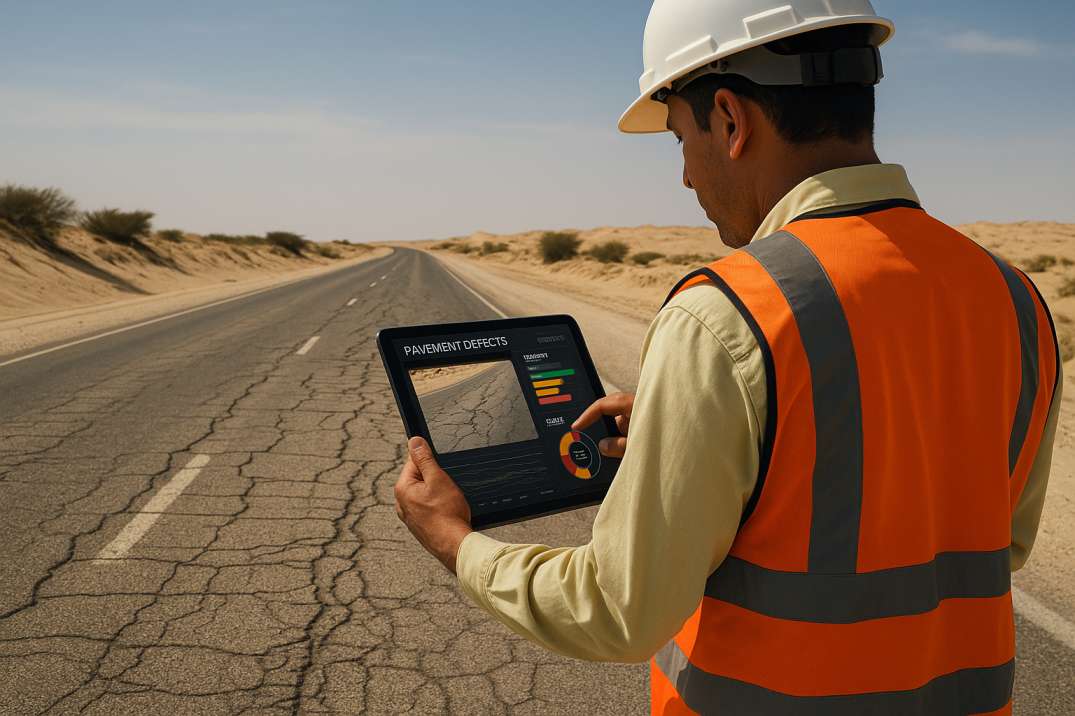Contact Us
RoadVision AI
Private Limited
Office No. 308 & 310, B Block
Ansal Chamber - 1, Bhikaji Cama Place,
Near Engineers India Limited (EIL) Bhawan, New Delhi - 110066
© 2024 | RoadVision AI | All rights reserved
Saudi Arabia’s vast and expanding road network—spanning over 221,000 kilometers—forms the backbone of its logistics, tourism, and economic development efforts, especially under the Vision 2030 framework. But maintaining road quality in desert environments is no easy task. Harsh climate conditions, sand ingress, high surface temperatures, and asphalt cracking create unique challenges that demand more than conventional inspection methods.
This is where AI-based road asset management emerges as a transformative force. Leveraging automated condition surveys, predictive analytics, and geospatial intelligence, AI can identify surface degradation well before it becomes visible to the naked eye. In this blog, we explore how AI technologies can revolutionize desert road maintenance in Saudi Arabia, align with official regulatory standards, and ultimately extend pavement life while reducing costs.

The Kingdom’s highways cross some of the most extreme environments in the world. According to the Saudi Ministry of Transport and Logistic Services (MoTLS), key maintenance challenges in desert terrain include:
Traditional road inspections conducted manually or via periodic surveys are not only resource-intensive, but they also fail to capture emerging threats in real time. This is especially risky on roads that support oil transport, Hajj pilgrimage, or mega projects like NEOM and The Line.
AI-powered road asset management systems like those from RoadVision AI combine multiple sensors—cameras, LiDAR, GPS, and cloud-based analytics—to monitor road conditions continuously and accurately. Here’s how AI specifically helps in Saudi desert environments:
Using vehicle-mounted or drone-mounted sensors, AI systems can identify:
Advanced platforms like RoadVision’s Pavement Condition Survey Tool score every segment using objective PCI (Pavement Condition Index) metrics, allowing early intervention.
Through AI-based visual analysis, the system detects:
These observations are geo-tagged and time-stamped, enabling targeted clearance and restoration.
By analyzing environmental, traffic, and historical performance data, AI models can forecast the remaining service life of pavement segments and predict:
This enables agencies to move from reactive to proactive road maintenance, optimizing resource allocation.
Saudi Arabia follows specific road codes and manuals developed by the MoTLS, including:
AI tools can be trained to flag non-compliance with design specs such as:
Systems like RoadVision’s Road Safety Audit ensure roads meet AASHTO and local compliance standards, especially in high-speed corridors.
Saudi Arabia is investing heavily in smart infrastructure. AI aligns perfectly with national goals by:
The use of RoadVision AI’s Inventory and Inspection Tools enables automated data logging, supporting better planning and investment decisions.
In regions such as Al-Qassim and Tabuk, road agencies piloted AI inspections to address:
Using RoadVision’s AI-powered platform, authorities detected over 1,200 actionable defects and optimized maintenance scheduling, cutting response times by 50%.
With tools ranging from road defect detection to traffic analysis, RoadVision AI provides:
You can also explore recent insights in the RoadVision Blog, where we cover trends, technologies, and updates on road intelligence systems.
Desert road maintenance in Saudi Arabia requires precision, speed, and adaptability. Manual inspections cannot match the pace or complexity of failures in such harsh terrains. With AI road asset management, agencies can shift to a data-driven, predictive, and cost-efficient maintenance strategy that aligns with the country’s development goals.
RoadVision AI is transforming road infrastructure development and maintenance with its innovative AI in road maintenance and AI in road construction solutions. By utilizing cutting-edge computer vision technology and digital twin models, the platform conducts comprehensive road safety audits, enabling the early detection of potholes, cracks, and other surface issues for timely repairs and enhanced road conditions. The use of AI in road safety also extends to traffic surveys, providing data-driven insights to tackle challenges like traffic congestion and optimize road usage. Focused on building smart roads, RoadVision AI ensures full compliance with IRC Codes, and aligns with SHC 101 and SHC 202 — Saudi Arabia’s official highway and infrastructure development codes — empowering engineers and stakeholders to reduce costs, minimize risks, and elevate road safety and transportation efficiency.
As infrastructure expands under Vision 2030, AI is no longer a luxury—it’s a necessity.
Book a demo with us today to explore how RoadVision AI can support your road maintenance and safety objectives across the Kingdom.
Q1. What is sand ingress and why is it a problem in Saudi roads?
Sand ingress is the accumulation of desert sand on road surfaces or shoulders, which reduces skid resistance, visibility, and can damage pavement.
Q2. How does AI detect road damage under sand cover?
AI uses infrared imaging, LiDAR, and pattern recognition to detect subsurface cracking or distress even if partially obscured by sand.
Q3. Are AI inspections accepted under Saudi road standards?
Yes, AI tools are being increasingly adopted by Saudi agencies as they align with MoTLS and Vision 2030 goals for smart and resilient infrastructure.